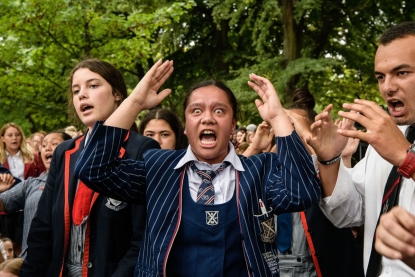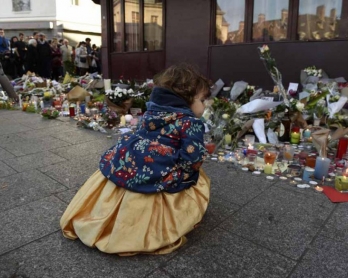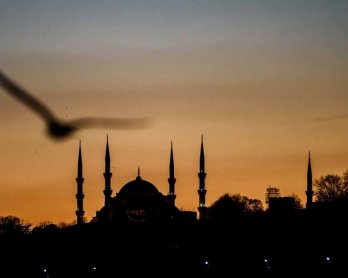The incredible kindness of beings
Christchurch, New Zealand -- The tears came without warning, as I watched them link arms, forming a protective human fence around their Muslim neighbors who were holding evening prayers in the park, just meters from where the killing took place.
 Muslims (front) pray in front of the Al Noor mosque while being protected by locals, moments after hundreds performed a mass haka, in Christchurch on March 20, 2019, five days after the twin mosque shootings claimed the lives of 50 people. (AFP / Anthony Wallace)
Muslims (front) pray in front of the Al Noor mosque while being protected by locals, moments after hundreds performed a mass haka, in Christchurch on March 20, 2019, five days after the twin mosque shootings claimed the lives of 50 people. (AFP / Anthony Wallace)That’s how it usually happens -- when you least expect it. As you cover the aftermath of a tragedy, you glimpse something that reminds you that goodness exists even in the darkest of places. And you crack.
There were so many such moments for the AFP team following the twin mosque massacre in Christchurch, New Zealand, in which a white supremacist rampage left 50 worshippers dead.
For photographer Anthony Wallace, it came when John Milne invited him inside his home and wept as he penned a heartbreaking open letter to his murdered 14-year-old son Sayyad.
 In this photo taken on March 19, 2019 in Lyttelton, close to Christchurch, local resident John Milne weeps while sitting on his bed as he writes an anguished letter on a whiteboard four days after his 14-year-old son Sayyad was killed in New Zealand's twin mosque massacre. (AFP / Anthony Wallace)
In this photo taken on March 19, 2019 in Lyttelton, close to Christchurch, local resident John Milne weeps while sitting on his bed as he writes an anguished letter on a whiteboard four days after his 14-year-old son Sayyad was killed in New Zealand's twin mosque massacre. (AFP / Anthony Wallace)For Sydney-based reporter Glenda Kwek, it was the locals who offered food and water as she stood at cordons, the spontaneous hugs from strangers, the feeling of never being treated like a pariah or a leech.
I dread being assigned to cover mass shootings. There’s something about the cold-hearted, clinical, methodical and entirely man-made nature of such slayings that makes covering them uniquely unpleasant. Natural disasters have an unavoidable quality to them, explosions are man-made but they happen in a split second. But mass shootings and hostage sieges go on and on, victim after victim, each with their own terrifying story of death or survival. It’s overwhelming.
But when the request comes in, I know I have a duty to recount people’s experiences with sensitivity, accuracy and empathy.
Sadly, tragedies are an unavoidable part of what journalists do . Whether it’s man-made or a natural phenomenon, a reporter heads into a disaster zone knowing that grim testimonies and scenes await. You tend to brace yourself for those. But you also witness kindness and that’s what usually gets to you.
 A group of students sings in front of flowers left in tribute to victims at the Botanical Garden in Christchurch on March 19, 2019, four days after a shooting incident at two mosques that claimed the lives of 50 people. (AFP / Anthony Wallace)
A group of students sings in front of flowers left in tribute to victims at the Botanical Garden in Christchurch on March 19, 2019, four days after a shooting incident at two mosques that claimed the lives of 50 people. (AFP / Anthony Wallace)I first heard something appalling had occured in the usually sleepy town of Christchurch while on holiday in Indonesia.
My sister, who has lived in the southern New Zealand city for more than a decade texted me.
“Not sure if this will make world news but Christchurch is currently in lockdown as there has been a shooting at a mosque near Hagley Park,” she wrote, adding she was trying to get to her two young children.
Within minutes the shooting had very much leapt to the top of the global headlines and media organisations scrambled to get journalists there. By the following day AFP had a team of some ten reporters in the city.
This massacre had an appallingly modern twist designed for the social media age we live in. The alleged gunman, 28-year-old Australian and self-declared white nationalist Brenton Tarrant, had live broadcast his murder spree on Facebook, knowing it would be replicated hundreds of thousands of times.
So long before world media could descend on the scene, the killer made sure his narrative was online for all to see.
As we rushed to catch flights, our fact-checker colleagues in Hong Kong had the grim task of repeatedly watching the video to verify its authenticity. The team decided the footage was real, but we did not offer it to clients.
I wrestled with whether to watch it as I waited for my plane in Bali. I eventually decided to do so. I needed to have an idea of what those people went through -- and what the gunman did. Other colleagues decided against and I entirely understand their choice.
 A church staff member walks past the fifty pairs of shoes lay outside the All Souls Church representing the 50 people gunned down at the two mosques in Christchurch on March 19, 2019. (AFP / Marty Melville)
A church staff member walks past the fifty pairs of shoes lay outside the All Souls Church representing the 50 people gunned down at the two mosques in Christchurch on March 19, 2019. (AFP / Marty Melville) A woman sits quietly across the road from the Masjid Al Noor mosque on March 19, 2019 in Christchurch, New Zealand, where worshipers were gunned down three days ago. (AFP / Marty Melville)
A woman sits quietly across the road from the Masjid Al Noor mosque on March 19, 2019 in Christchurch, New Zealand, where worshipers were gunned down three days ago. (AFP / Marty Melville)
It took me only three minutes to find a copy of the video a few pages deep on YouTube. I’ve watched unpleasant footage before -- bombings, shootings, the scorched earth campaign against the Rohingya in Myanmar, jihadist videos. But this was something else. On the one hand, sadness and anguish washed over me. On the other, I was angry, bile literally rising in my throat. The video looked like a computer game and it seemed clear to me the killer was trying to emulate this. Except that every time someone dropped, you realized that it was a real person, torn apart by a relentless barrage of bullets. These are actual people, I thought as I watched the images. Our job this week will be to tell the world who they are. Focus on the victims.
We all had a fairly good idea of what lay ahead. Most of the team have covered tragedies before, from earthquakes and typhoons to terror attacks, building collapses and homicides.
I had actually covered a white supremacist massacre before -- the 2011 murder of 77 mostly young people, by Anders Behring Breivik in Norway.
The initial days were dominated by the harrowing accounts of those who survived and those who didn’t, the devastated families, the agonising waits in hospital, the funerals and the inevitable but necessary exploration of who the mass murderer was.
People are usually very willing to talk after a tragedy, especially in those first few days. Perhaps there’s a cathartic quality to talking to a reporter early on, but generally people want the world to know what happened to them and their loved ones.
But after a while, a sense of media fatigue sets in. A close-knit community, reeling from the sheer loss meted out to them, understandably tires of the press presence. They have enough to deal with as it is and they know the world’s interest is inherently fleeting. A reporter has to remain alert to these sensitivities.
 Residents cry after leaving flowers in tribute to victims in Christchurch, on March 17, 2019, two days after a shooting incident at two mosques in the city. (AFP / Anthony Wallace)
Residents cry after leaving flowers in tribute to victims in Christchurch, on March 17, 2019, two days after a shooting incident at two mosques in the city. (AFP / Anthony Wallace)What was remarkable in New Zealand was the absence of this fatigue. People were warm and open throughout the aftermath of the shootings. That warmth came through the most in the extraordinary displays of support for the country’s reeling tiny Muslim community.
There were the emotional haka dances by school children and biker gangs..
 School students perform the haka during a vigil in Christchurch on March 18, 2019, three days after a shooting incident at two mosques in the city that claimed the lives of 50 Muslim worshippers. (AFP / Anthony Wallace)
School students perform the haka during a vigil in Christchurch on March 18, 2019, three days after a shooting incident at two mosques in the city that claimed the lives of 50 Muslim worshippers. (AFP / Anthony Wallace) Members of a New Zealand biker gang perform the haka in tribute of those killed in the March 15 Christchurch twin mosque massacre, outside the Jamia Masjid mosque in Hamilton on March 22, 2019. (AFP / Michael Bradley)
Members of a New Zealand biker gang perform the haka in tribute of those killed in the March 15 Christchurch twin mosque massacre, outside the Jamia Masjid mosque in Hamilton on March 22, 2019. (AFP / Michael Bradley)
...the enormous crowds for Friday prayers one week after the massacre...
 People pray during congregational Friday prayers and two minutes of silence for victims of the twin mosque massacre, at Hagley Park in Christchurch on March 22, 2019. (AFP / William West)
People pray during congregational Friday prayers and two minutes of silence for victims of the twin mosque massacre, at Hagley Park in Christchurch on March 22, 2019. (AFP / William West)
...the Maori men who shared traditional ‘hongi’ nose greetings with Muslims after those prayers...
 A Muslim man (R) and another local perform a traditional Maori 'hongi' greeting, a touching of noses, during a gathering for congregational Friday prayers and two minutes of silence for victims of the twin mosque massacre, at Hagley Park in Christchurch on March 22, 2019. (AFP / Jerome Taylor)
A Muslim man (R) and another local perform a traditional Maori 'hongi' greeting, a touching of noses, during a gathering for congregational Friday prayers and two minutes of silence for victims of the twin mosque massacre, at Hagley Park in Christchurch on March 22, 2019. (AFP / Jerome Taylor)the defiant speeches decrying the gunman’s hatred; the embrace of Prime Minister Jacinda Ardern’s phrase “They are us”, the adoption by many Kiwi women of hijab for a day.
 A police officer wearing a head scarf stands guard during a funeral ceremony at the Memorial Park in Christchurch on March 22, 2019. (AFP / Marty Melville)
A police officer wearing a head scarf stands guard during a funeral ceremony at the Memorial Park in Christchurch on March 22, 2019. (AFP / Marty Melville)That warmth was also extended to us, journalists, making it much easier for us to do our job. And those most directly affected by the murders were often the ones warmest with us.
Somehow taxi-driver Abdulkadir Ababora survived the massacre at Al Noor unscathed, diving under a bookshelf that usually held Korans. He became a key go between for our team, helping us sensitively reach out to other survivors and victims who wanted the world to hear their stories.
There was Mo -- an Australian specialist who spent three days and nights with a team of volunteers undertaking the grim task of washing all the bodies of those killed according to Islamic practice. He wanted the world to understand the care being provided to the victims and to praise the local Christchurch doctors who helped them. But he asked us not to use his full name because he didn’t want publicity.
 A young girl places a note among flowers left in tribute to victims in Christchurch, on March 17, 2019, two days after a shooting incident at two mosques in the city. (AFP / Anthony Wallace)
A young girl places a note among flowers left in tribute to victims in Christchurch, on March 17, 2019, two days after a shooting incident at two mosques in the city. (AFP / Anthony Wallace)Then there was the Nabi family, whose 71-year-old patriarch Mohemmed Daoud Nabi was the first victim, gunned down as he greeted his killer with the words “Hello brother”. In the midst of the chaos and distress of his funeral, the family openly welcomed our reporting team in to witness and record their final goodbyes.
Many spoke of their desire to ensure the memory of their loved ones were permanently preserved and to show that the gunman had failed to divide New Zealand.
 Alaska Wood, 26, (centre L) comforts Mohammed Nadir, 58, (centre R) as he cries while taking part in a two minute silence for twin mosque massacre victims in a park near the Al Noor mosque in Christchurch on March 22, 2019. (AFP / Anthony Wallace)
Alaska Wood, 26, (centre L) comforts Mohammed Nadir, 58, (centre R) as he cries while taking part in a two minute silence for twin mosque massacre victims in a park near the Al Noor mosque in Christchurch on March 22, 2019. (AFP / Anthony Wallace)Throughout his time in the city, Hong Kong-based photographer Anthony Wallace kept a white board in his backpack and asked those he came across to write a message for the outside world.
Most chose messages of unity and defiance.
"I love New Zealand. We stand united", wrote Zeynia Endrise, whose husband Abbas had to fight for his life after being shot in his right lung.
Atish, a 38-year-old Muslim man in a dark shalwar kameez and prayer cap, wanted to call for restraint. "There is no time for hate," he wrote.










It was John Milne, who lost his son, who wrote the last message on that board.
John became well known to many of the reporters in Christchurch that week because he displayed his love for his murdered son Sayyad so openly and vocally.
He would talk for long periods about how Sayyad was a promising goalie who dreamed of playing for Manchester United. For much of the week he wore Sayyad’s sandals on his feet.
 In this photo taken on March 19, 2019 in Lyttelton, close to Christchurch, local resident John Milne gestures as he stands on his balcony, four days after his 14-year-old son Sayyad was killed in New Zealand's twin mosque massacre. (AFP / Anthony Wallace)
In this photo taken on March 19, 2019 in Lyttelton, close to Christchurch, local resident John Milne gestures as he stands on his balcony, four days after his 14-year-old son Sayyad was killed in New Zealand's twin mosque massacre. (AFP / Anthony Wallace)John invited Anthony home and showed him around Sayyad’s now empty room, the now empty bed, the undisturbed clothes.
Instead of a short message, he used the whiteboard to write a long letter to his son, describing him as a ‘brave lion” and “special little one” who had to fight from his troubled birth onwards.
The message was so beautiful and personal that Anthony felt unable to take the whiteboard back.
John said he would keep it untouched and it now rests in Sayyad’s room.
I like to think that board is a small piece of our reporting team in Christchurch in the same way the city and its people have very much left an imprint on us.
 This photo taken on March 19, 2019 in Lyttelton, close to Christchurch, shows a photo of Sayyad Milne as a young boy and a whiteboard with a letter written to him by his father, John Milne, placed on a table in Sayyad's room, four days after he was killed in New Zealand's twin mosque massacre at the age of 14. (AFP / Anthony Wallace)
This photo taken on March 19, 2019 in Lyttelton, close to Christchurch, shows a photo of Sayyad Milne as a young boy and a whiteboard with a letter written to him by his father, John Milne, placed on a table in Sayyad's room, four days after he was killed in New Zealand's twin mosque massacre at the age of 14. (AFP / Anthony Wallace)




